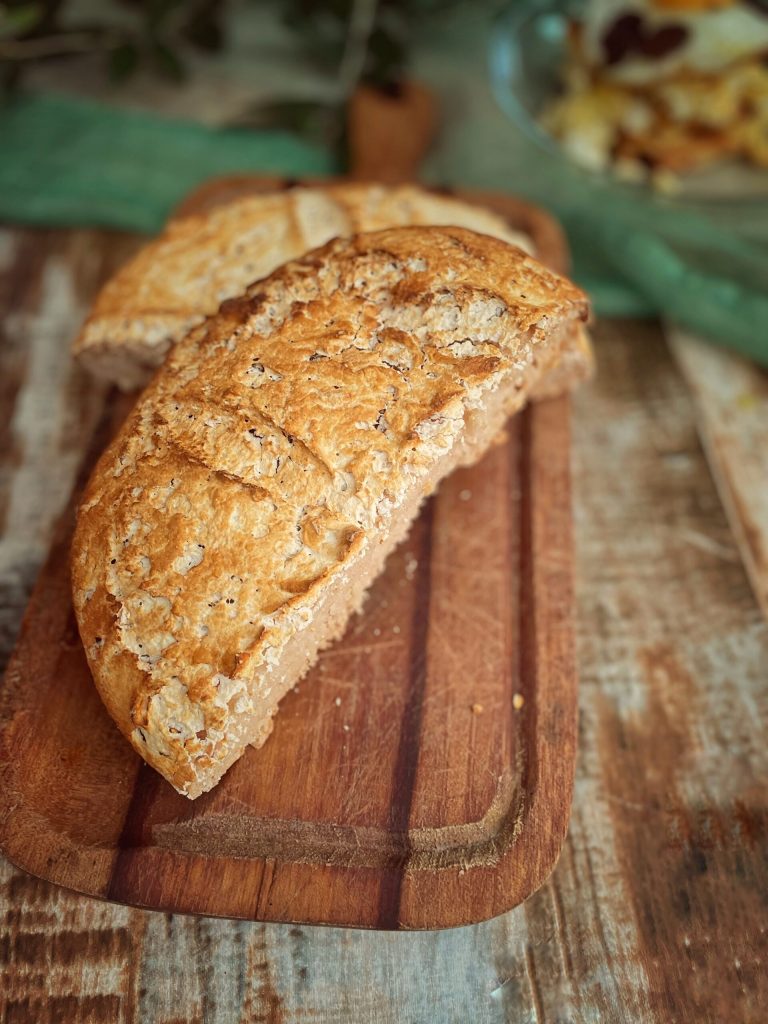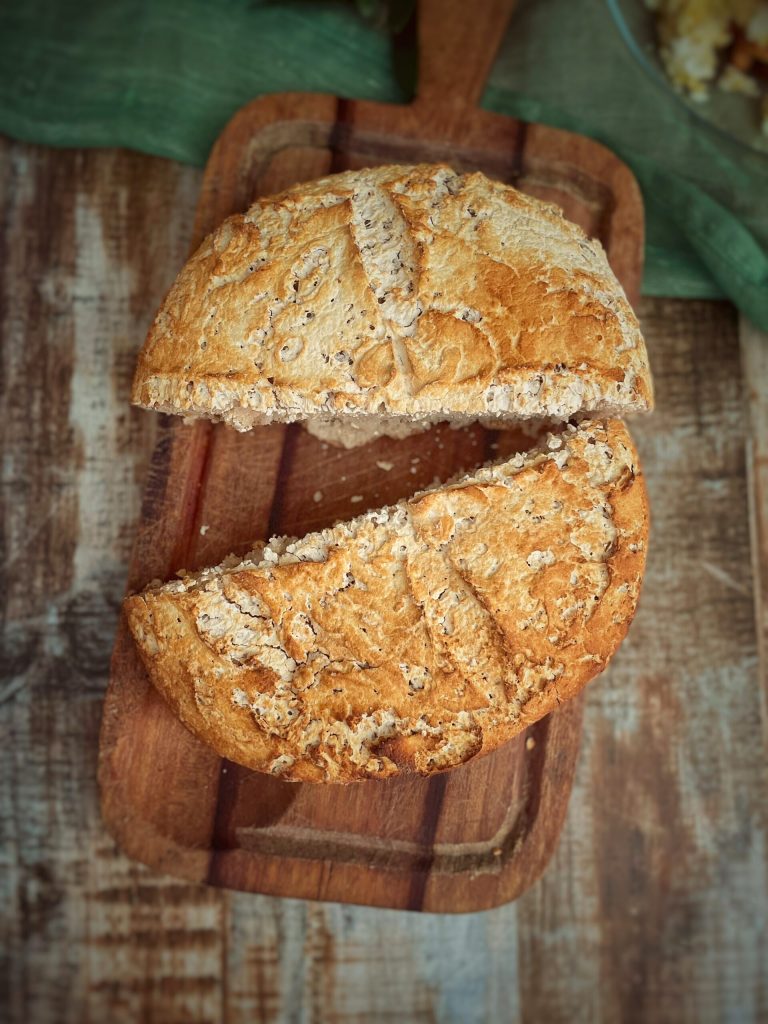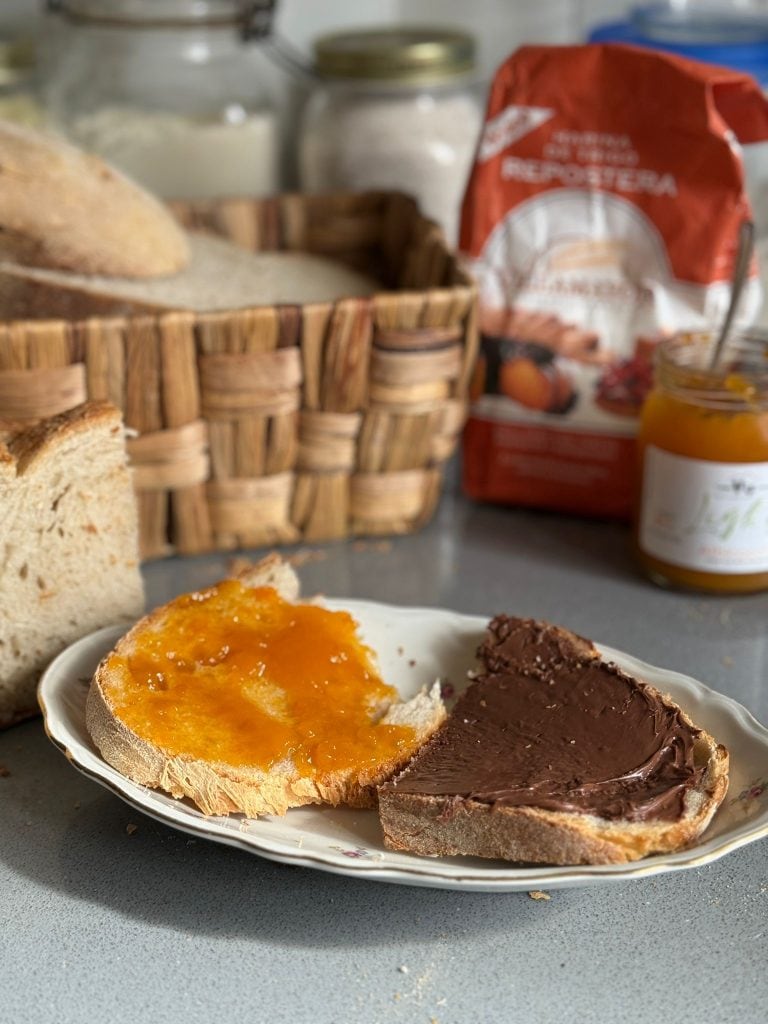The pan de pueblo is a rustic bread typical of rural areas in Spain, characterized by a thick and crunchy crust and a dense and flavorful crumb.
It is not a specific type of bread, but a generic term that refers to artisanal and traditional bread, like the Catalan “pan payés” or the Galician “pan de Cea” or the “hogaza”, made with local flours and ancient methods, similar to what a farmer would make in his “pueblo”.
All use slow leavening, often with sourdough (at the bottom you will find the traditional recipe of my colleague Sara from the SaraBuonoDavvero blog).
It usually has a round shape and a rustic appearance, as in the case of the “hogaza” loaf, typical of Castile and León (but also in other regions) with a thick crust and alveolated crumb.
Hogaza is my choice, which I propose to you in gluten-free version with sourdough, served with huevos rotos con trufa (truffle).
In ancient Spanish cuisine, it was considered the bread of shepherds and farmers. Traditionally, the large loaf (900 gr) was prepared by everyone at home, kneaded and baked once a week.
The term derives from the Latin focācia, linked to the concept of a “hearth”, emphasizing its domestic and community origin.

- Difficulty: Easy
- Cost: Very cheap
- Rest time: 10 Hours
- Preparation time: 10 Minutes
- Portions: 1 Piece
- Cooking methods: Oven, Electric oven
- Cuisine: Spanish
- Seasonality: All seasons
Ingredients
- 15.87 oz gluten-free flour mix
- 5.29 oz fresh gluten-free sourdough (refreshed and active)
- 1.69 cups warm water
- 2 tsp salt
Steps
Mix the dry ingredients:
In a large bowl, combine the flour mix and salt.
Add the liquid ingredients:
Incorporate the active sourdough and warm water.
Mix until you obtain a homogeneous and sticky dough.
First rise:
Cover the bowl with a damp cloth and let rise at room temperature for 8 hours, until doubled in volume.
Shape the loaf:
Transfer the dough onto a lightly floured surface with gluten-free flour.
With wet hands, shape it into a round loaf.
Second rise:
Place the loaf on a baking sheet lined with parchment paper.
Cover and let rise for another 1–2 hours.
Preheat the oven:
Bring the oven to 392°F.
Bake the bread:
Before baking, make slashes on the surface of the loaf.
Bake for 45–50 minutes.
Hogaza and Ligurian Focaccia
The term “hogaza” derives, as mentioned, from the Latin focācia, just like the Ligurian focaccia, but over time the two products have evolved in very different directions.
The name has the same origin, but the hogaza is not a focaccia in the modern Italian sense: it is a rustic and dry loaf, more similar to homemade bread.
FAQ (Questions and Answers)
The “pan payés” Catalan or the “pan de Cea” Galician or the “hogaza” are all pan de pueblo. What is the difference between them? What other types of pan de pueblo exist?
Yes, pan payés (Catalonia), pan de Cea (Galicia), and hogaza (Castile and other regions) are all regional variants of “pan de pueblo”, the traditional rustic bread of Spanish villages.
However, they have some differences related to:
Origin and territory
Pan payés: typical of Catalonia; round, with a dense and moist crumb. Often used for pa amb tomàquet.
Pan de Cea: PDO bread from Galicia; elongated oval shape, very thick crust, compact crumb, long leavening.
Hogaza: rustic bread typical of Castile and León (but also in other regions); round, with a thick crust and alveolated crumb.
Flours
Payés: soft wheat flour, often mixed with a small percentage of whole wheat flour.
Cea: local wheat flour (typically hard), stone-ground.
Hogaza: can be made with white or whole wheat flour, depending on the area.
Leavening
All use slow leavening, often with sourdough.
The pan de Cea has very precise rules, being a PDO.
Other types of pan de pueblo:
De Alfacar (Granada): traditional Andalusian bread with PGI.
Pan de Valladolid: known for its crispy crust and often ring-shaped format.
De Cruz (Ciudad Real): cross engraved on top, hard crust, dense crumb.
Pan de escanda (Asturias): made with spelt (ancient grain).
León and Zamora: large-format bread with creamy crumb and hard crust, often accompanied by traditional dishes like roasts and cured meats.
Porriño (Galicia): hogaza with dark and alveolated crumb, thick crust often dusted with flour.
Castellón (Valencian Community): known as fogassa, has a softer crumb and a flatter shape, due to the use of local flours.
Pan de Cruz (Ciudad Real): hogaza with a cross-shaped incision on the surface, recognized with Protected Geographical Indication (PGI).
Boba (Andalusia and La Mancha): round and flattened bread, often used as a “container” for other foods, thanks to its central incision that allows it to be easily divided.What is the recipe for huevos rotos con trufa?
Huevos Rotos with Truffle (for 2 people)
Ingredients:
3 medium potatoes
6 fresh eggs
Extra virgin olive oil or seed oil for frying
Salt and pepper to taste
Fresh black truffle or truffle carpaccio – which you can buy with a €5 discount, code viaggiando5 on the website: Deus Tartufi.
Procedure:
Prepare the potatoes:
Peel and cut the potatoes into sticks or thin slices.
Fry them in plenty of oil until golden and crispy.
Drain on absorbent paper and lightly salt.
Fry 1 egg and cook the other eggs in a pan with a little oil, leaving the yolk very soft. Season with salt and pepper.
Assemble the dish:
Place the potatoes on a large plate, add the scrambled eggs on top, the fried egg, and finally the truffle.
What is the traditional recipe for Pan de pueblo?
For a traditional Pan de pueblo recipe, understood as homemade bread with flour and sourdough, I invite you to follow the one by my blogger colleague Sara from the SaraBuonoDavvero blog which you can find here.


